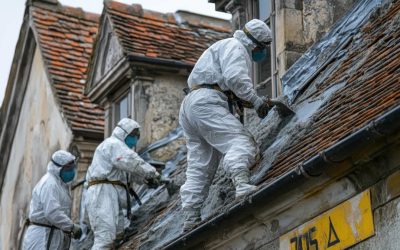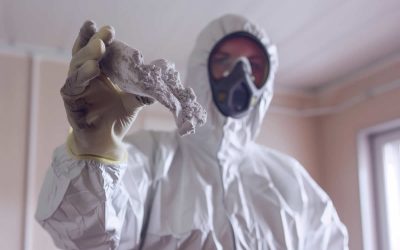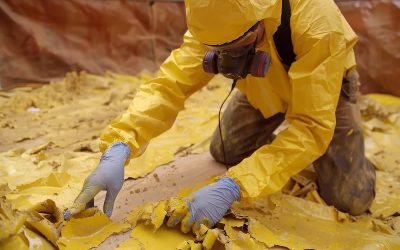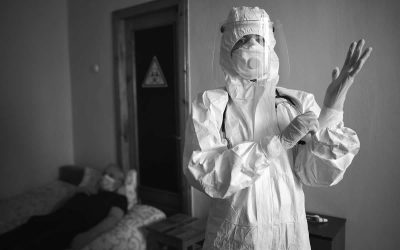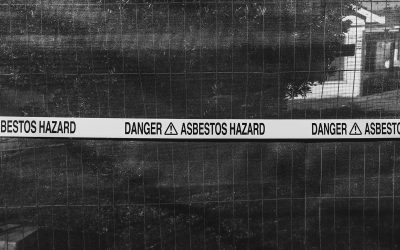If you’re dealing with an older building—maybe you’re doing some work in your loft, looking inside your walls, or checking pipes in your basement—you might come across something that makes you pause. It could be dusty, crumbly, or wrapped around old heating systems. And you start to wonder: is that asbestos?
It’s a fair question. Asbestos insulation doesn’t exactly come with a warning label. And because it was used in so many ways, it can look very different depending on where you find it.
In this guide, we’re going to break it down clearly. We’ll walk through the types of asbestos insulation, what they look like, where they’re usually found, and what to do if you think you’ve come across it.
By the end, you’ll feel more confident about spotting potential asbestos insulation—without needing to be an expert.
Why Was Asbestos Used in Insulation?
First, let’s talk about why asbestos ended up in insulation in the first place. For a long time, asbestos was seen as a miracle material. It was heat-resistant, fireproof, and durable. It didn’t rot, didn’t melt, and didn’t cost much.
That made it perfect for insulation—especially in homes, factories, schools, and public buildings built from the 1930s right up until the late 1990s. Asbestos was used to insulate boilers, pipework, lofts, walls, and ceilings.
If your home or building was built or refurbished before the year 2000, there’s a chance it contains some form of asbestos insulation.
Why It’s Hard to Spot
One of the biggest challenges is that asbestos doesn’t always look the same. Depending on how it was used, it can appear fluffy, crumbly, solid, smooth, or dusty. It’s often mixed with other materials, so it doesn’t have a distinct appearance. You can’t always tell just by looking.
That’s why it’s important to understand where you might find it and the different forms it takes.
Let’s go through the most common types of asbestos insulation and what each one looks like.
Loose-Fill Asbestos Insulation
Loose-fill asbestos is one of the most dangerous forms. It’s exactly what it sounds like—loose, fluffy fibres that were poured into cavities, lofts, and floor spaces. It was used to fill gaps and block heat loss.
What it looks like:
- It resembles grey or white cotton wool.
- The texture is soft and very light.
- It often looks fluffy or cloud-like.
Because it’s so loose and lightweight, it can easily release fibres into the air if disturbed. You should never touch it. If you see something that looks like this in your loft or behind a wall, stop what you’re doing and get a professional to check it.
Asbestos Lagging
Lagging is a form of insulation used to wrap around hot water pipes, steam pipes, and boilers. It was very common in older homes and industrial settings.
What it looks like:
- It’s usually a greyish-white or off-white material.
- It might be wrapped in cloth or paper.
- The surface may look rough, powdery, or fibrous.
- It’s often shaped like tubes or sleeves around pipes.
Over time, lagging can break down and crumble, especially if it’s been exposed to moisture or movement. That’s when it becomes more dangerous—because the fibres are more likely to get into the air.
Lagging often sits inside older boiler cupboards, behind walls, or under floors. If you see it, don’t try to remove it or even disturb it. It’s classed as high-risk material.
Sprayed Asbestos Insulation
Sprayed coatings were used to insulate large areas quickly. You’ll find this type of asbestos in commercial buildings, warehouses, or older housing estates. It was sprayed onto ceilings, walls, and steel structures for fire protection.
What it looks like:
- It has a rough, uneven texture.
- It’s usually grey or white.
- It might flake or peel off at the edges.
- Sometimes it’s painted over or sealed in place.
This form of asbestos is particularly dangerous because it can break down very easily. If it’s disturbed, it can release a high number of fibres in very little time.
If you’re looking up at an old warehouse ceiling or inside a plant room and see something rough and patchy sprayed onto beams or panels, it might be asbestos.
Asbestos Insulating Board (AIB)
This type of insulation was used a lot in the 1960s and 70s. You’ll find it in wall partitions, fireproof panels, ceiling tiles, or around boiler cupboards and airing cupboards. It looks a bit like standard plasterboard but contains asbestos fibres.
What it looks like:
- Flat, solid boards—often off-white or pale grey.
- Slightly fibrous texture on broken edges.
- Can be mistaken for standard plasterboard or fibreboard.
AIB isn’t as easy to crumble as loose-fill or lagging, but it still poses a serious risk if it’s cut, drilled, or sanded. It releases fibres when it’s damaged.
This is one of the most common forms of asbestos insulation found in homes today.
Asbestos-Backed Linings and Paper
In some cases, asbestos was added as a lining behind insulation materials—like on the back of floor tiles, inside fuse boxes, or behind heaters.
What it looks like:
- Very thin, sometimes almost like cardboard or thick paper.
- White, grey, or even brown in colour.
- Often hidden behind panels or fixed surfaces.
Because it’s so thin, this type can go unnoticed. But once you peel something back, it can become exposed. It’s best to treat any unknown lining in an older building as suspicious until you’ve had it tested.
So How Do You Know For Sure?
The truth is—you can’t be 100% sure just by looking. Asbestos insulation can resemble other materials. It can be hidden behind paint, inside walls, or sealed under other coverings.
If you think you’ve found something that might be asbestos insulation, the best thing to do is stop what you’re doing and call in a licensed asbestos surveyor. They’ll be able to take samples and get them tested properly.
The only way to confirm asbestos is through lab testing. That’s what makes it official. No amount of guesswork or Google images can take the place of a proper test.
What To Do If You Think You’ve Found Asbestos Insulation
Here’s what you should do if you spot something that looks like asbestos insulation:
- Don’t touch it, move it, or break it.
- Stop any work that’s going on.
- Keep the area sealed off if you can.
- Avoid sweeping or vacuuming near it—this spreads fibres.
- Call a licensed asbestos professional to inspect and advise.
What If You’ve Already Disturbed It?
If you’ve already disturbed something—maybe you started pulling up insulation, cutting through a wall, or stripping old pipe coverings—and then realised it could be asbestos, stop straight away.
Leave the room. Close the door behind you. Wash your hands and face. Don’t go back in. Then get someone qualified to come and assess the situation.
Even small amounts of disturbed asbestos can pose a risk, especially if it’s high-risk material like loose-fill or sprayed coating.
Is Asbestos Still a Problem?
Yes. Even though it was banned in the UK in 1999, it’s still sitting quietly in millions of homes, schools, factories, and office buildings. The ban stopped new materials from being used—but it didn’t remove what was already in place.
That’s why it’s so important to know what asbestos insulation looks like and where it might be hiding. As long as it’s left alone and in good condition, it’s usually not a risk. But if you’re planning building work, it’s something you need to think about in advance.
Should You Remove It?
Not always.
Sometimes, asbestos insulation can be left in place and sealed properly. This is called encapsulation. It prevents the fibres from escaping and keeps the area safe.
In other cases, removal is the best option—especially if the material is damaged, likely to be disturbed, or in poor condition. This work must be done by professionals with the right equipment and training. DIY asbestos removal is dangerous and, in most cases, illegal.
Final Thoughts
So, what does asbestos insulation look like?
There’s no single answer. It depends on where it is and what form it takes. It could be loose and fluffy in your loft, crumbly and wrapped around pipes, or flat and solid inside your airing cupboard.
What matters most is knowing what to watch for and how to act when you see something suspicious. If your building was put up before 2000 and you spot old insulation that looks odd—don’t guess. Don’t touch it. Just get it checked.
A professional test can give you peace of mind and help you avoid serious risks down the line. When it comes to asbestos, it’s always better to be safe than sorry.
Are you looking for Asbestos Disposal in Bristol? If so, contact us now!



